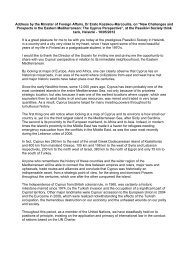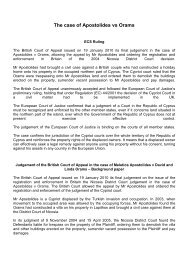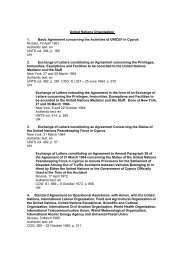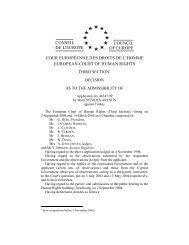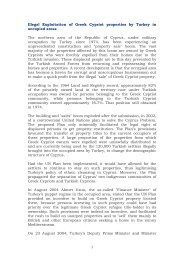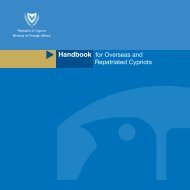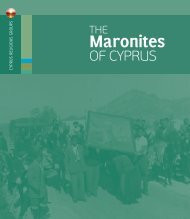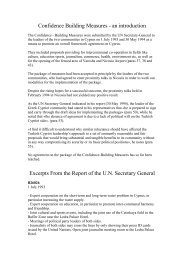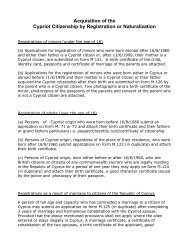CAAG INSIDE ENGLISH 2011_Layout 1.qxd - Ministry of Foreign ...
CAAG INSIDE ENGLISH 2011_Layout 1.qxd - Ministry of Foreign ...
CAAG INSIDE ENGLISH 2011_Layout 1.qxd - Ministry of Foreign ...
Create successful ePaper yourself
Turn your PDF publications into a flip-book with our unique Google optimized e-Paper software.
P.I.O. 151/<strong>2011</strong> - 5.000 - English ISBN 978-9963-50-017-8<br />
Published by the Press and Information Office, Republic <strong>of</strong> Cyprus<br />
www.moi.gov.cy/pio<br />
Printed by Zavallis Litho Ltd<br />
Cyprus at a glance
Note: Unless otherwise noted all statistical data refers to the area <strong>of</strong> the Republic <strong>of</strong> Cyprus controlled by<br />
the government <strong>of</strong> Cyprus and does not apply to the area under military occupation by Turkey since 1974.<br />
The sale or other commercial exploitation <strong>of</strong> this publication or part <strong>of</strong> it is strictly prohibited.<br />
Excerpts from the publication may be reproduced with appropriate acknowledgement <strong>of</strong> this<br />
publication as the source <strong>of</strong> the material used.<br />
Press and Information Office publications are available free <strong>of</strong> charge.
A Message from the President <strong>of</strong> the<br />
Republic <strong>of</strong> Cyprus H.E. Mr Demetris Christ<strong>of</strong>ias<br />
In 2010 Cyprus proudly<br />
celebrated its fiftieth<br />
anniversary as an independent<br />
state. The anniversary marked<br />
the modern historical course <strong>of</strong><br />
our country and its people.<br />
In 1960 the Republic <strong>of</strong> Cyprus<br />
joined the family <strong>of</strong> nations<br />
after a protracted anti-colonial<br />
liberation struggle by our<br />
people to win the right to selfdetermination.<br />
Since winning their independence, it became necessary<br />
for our people to undertake new hard struggles to<br />
defend it, and to defend the sovereignty, the freedom<br />
and the territorial integrity <strong>of</strong> our country.<br />
The Republic <strong>of</strong> Cyprus faced many problems during the<br />
first years <strong>of</strong> its existence: problems in the functioning <strong>of</strong><br />
the state, but also problems resulting from foreign<br />
interference in the domestic affairs <strong>of</strong> our country,<br />
which culminated with the 1974 illegal military invasion<br />
and occupation <strong>of</strong> a large part <strong>of</strong> its sovereign territory<br />
by neighbouring Turkey. Our people still suffer the tragic<br />
consequences <strong>of</strong> Turkey’s ongoing military aggression.<br />
Our firm goal remains a peaceful settlement to the<br />
Cyprus problem to terminate Turkey’s occupation and<br />
colonisation, and to reunite Cyprus in the context <strong>of</strong> a<br />
functional and viable bizonal, bicommunal federation<br />
that restores and safeguards the human rights and basic<br />
freedoms for its entire population.<br />
The Republic <strong>of</strong> Cyprus has shown remarkable resilience<br />
over time and has achieved great progress in all spheres <strong>of</strong><br />
life. It has been transformed from a poor, underdeveloped<br />
island, into a modern, thriving democracy, a respected<br />
member <strong>of</strong> the international community and an energetic<br />
and equal member <strong>of</strong> the European Union. Our<br />
government and people are, therefore, proud to hold the<br />
rotating EU presidency in the second half <strong>of</strong> 2012.<br />
We pay tribute to all those who made sacrifices for the<br />
liberation <strong>of</strong> our country, in defence <strong>of</strong> its independence<br />
as well as for the protection and strengthening <strong>of</strong> its<br />
democratic institutions. Drawing the right lessons from<br />
the past, we carry on with optimism and determination<br />
in order to meet the challenges and demands <strong>of</strong> our<br />
time and to move Cyprus forward.<br />
We are committed to reunite Cyprus and to transform it<br />
into an island <strong>of</strong> everlasting peace and prosperity for all<br />
its people.
2<br />
The Republic <strong>of</strong> Cyprus<br />
The State<br />
Kypriaki Democratia (Greek), Kibris Cumhuriyeti<br />
(Turkish), Republic <strong>of</strong> Cyprus (English)<br />
Independence Day: 1 October<br />
Cyprus gained its independence from British colonial<br />
rule in 1960. In 1974 Turkey invaded Cyprus and<br />
occupied 36,2% <strong>of</strong> its sovereign territory. The ceasefire<br />
line runs right across the island and cuts through the<br />
heart <strong>of</strong> the capital, Nicosia (Lefkosia), dividing the city<br />
and the country.<br />
Although its northern part is under foreign<br />
occupation, the Republic <strong>of</strong> Cyprus is internationally<br />
recognised as the sole legitimate State on the island<br />
with sovereignty over its entire territory.<br />
The Flag<br />
The flag <strong>of</strong> the Republic <strong>of</strong> Cyprus was defined in 1960<br />
when Cyprus became an independent sovereign state.<br />
The background is white with a copper-coloured<br />
silhouette <strong>of</strong> the map <strong>of</strong> Cyprus in the centre <strong>of</strong> the<br />
flag above two crossed olive-green-coloured olive<br />
branches. The copper colour has a dual symbolism:<br />
first, the name <strong>of</strong> the island is said to derive from an<br />
ancient word for copper (Eteocypriot or Sumerian);<br />
and second, copper is closely associated with Cyprus<br />
since antiquity when the island became a major<br />
producer and supplier <strong>of</strong> this mineral resource. The<br />
olive branches are symbols <strong>of</strong> peace.<br />
The Emblem<br />
The Emblem <strong>of</strong> the Republic <strong>of</strong> Cyprus depicts a white<br />
dove carrying an olive branch in its beak and placed<br />
inside a shield in the colour <strong>of</strong> copper (a metal directly<br />
related to Cyprus since ancient times); the year “1960”,<br />
also in white, appears underneath the dove; the shield<br />
is braced by two olive-green-coloured olive branches,<br />
which along with the white dove constitute symbols<br />
<strong>of</strong> peace.
Government<br />
Cyprus is an independent sovereign Republic with a<br />
presidential system <strong>of</strong> government. The constitution<br />
provides for separate executive, legislative and judicial<br />
branches <strong>of</strong> government with independent powers.<br />
The President is both Head <strong>of</strong> State and Government.<br />
Executive<br />
Presidency<br />
According to the 1960 Constitution, the President is to be<br />
Greek Cypriot elected directly by the Greek Cypriot<br />
community and the Vice-President is to be Turkish Cypriot<br />
elected directly by the Turkish Cypriot community, for a<br />
five-year term <strong>of</strong> <strong>of</strong>fice.<br />
The Constitution provides that executive power is<br />
exercised jointly by the President and the Vice-President,<br />
through a Council <strong>of</strong> Ministers appointed by them (seven<br />
and three ministers respectively). Both the President and<br />
the Vice-President have the right <strong>of</strong> final veto on decisions<br />
<strong>of</strong> the Council <strong>of</strong> Ministers and laws or decisions <strong>of</strong> the<br />
House <strong>of</strong> Representatives concerning foreign affairs,<br />
defence and security. In 1964, however, the Turkish<br />
Cypriot Vice-President and three ministers withdrew from<br />
the government and since then the government has been<br />
functioning by necessity only with Greek Cypriots in all<br />
ministries,which have been subsequently increased to<br />
eleven. The post <strong>of</strong> Vice-President remains vacant.<br />
Council <strong>of</strong> Ministers<br />
The Council <strong>of</strong> Ministers exercises executive power in<br />
all matters. Each Minister is the head <strong>of</strong> his or her<br />
<strong>Ministry</strong> and exercises executive power on all matters<br />
within that <strong>Ministry</strong>’s domain.<br />
The Government Spokesman and the Deputy Minister<br />
to the President are also present at the meetings <strong>of</strong> the<br />
Council <strong>of</strong> Ministers.<br />
3
4<br />
Legislature<br />
House <strong>of</strong> Representatives<br />
Legislative authority is exercised by a unicameral House<br />
<strong>of</strong> Representatives. Its members are elected for a fiveyear<br />
term. At the time <strong>of</strong> its establishment the House<br />
consisted <strong>of</strong> 50 members, 35 <strong>of</strong> whom were to be Greek<br />
Cypriots and 15 Turkish Cypriots. In 1985 the number <strong>of</strong><br />
seats was increased to 80, 56 allocated to Greek Cypriot<br />
members and 24 reserved for Turkish Cypriot deputies.<br />
Following the withdrawal <strong>of</strong> the Turkish Cypriot<br />
members in 1964, the House has been functioning<br />
only with the Greek Cypriot members.<br />
The Maronite, Armenian and Latin religious groups,<br />
which vote as part <strong>of</strong> the Greek Cypriot community,<br />
elect one additional representative each from their<br />
ranks. These non-voting representatives attend<br />
meetings but do not participate in the House<br />
deliberations. They are consulted on issues <strong>of</strong><br />
particular interest to their respective group.<br />
The President <strong>of</strong> the Republic <strong>of</strong> Cyprus is invested in<br />
<strong>of</strong>fice by the House <strong>of</strong> Representatives.<br />
Since the vacancy <strong>of</strong> the Vice-President’s <strong>of</strong>fice in 1964,<br />
the President <strong>of</strong> the House serves as Acting President<br />
<strong>of</strong> the Republic in the absence or temporary incapacity<br />
<strong>of</strong> the President <strong>of</strong> the Republic.<br />
Judiciary<br />
The judiciary is established as a separate power,<br />
independent from the other two branches <strong>of</strong> the state<br />
and autonomous in its sphere <strong>of</strong> competencies,<br />
authority and jurisdiction.<br />
The Supreme Court<br />
The Supreme Court is the highest court and is<br />
composed <strong>of</strong> thirteen judges, one <strong>of</strong> whom is the<br />
President. It has jurisdiction to examine the<br />
constitutionality <strong>of</strong> any law or any conflict <strong>of</strong> power or<br />
competence which arises between any organs or<br />
authorities <strong>of</strong> the Republic. In addition, it hears and<br />
determines any recourse by the President <strong>of</strong> the<br />
Republic regarding the compatibility with the<br />
constitution <strong>of</strong> any law enacted by the House <strong>of</strong><br />
Representatives. As the final Appellate Court <strong>of</strong> the<br />
Republic, it has jurisdiction to hear and determine all<br />
appeals from lower courts in civil and criminal matters.<br />
Functioning as the Electoral Court, it has the power to<br />
hear and determine petitions concerning the<br />
interpretation and application <strong>of</strong> the Electoral Laws. It<br />
also functions as an Admiralty Court with original and<br />
appellate jurisdiction.
First Instance Courts<br />
The principal First Instance Courts are the District<br />
Courts operating in every district <strong>of</strong> the Republic with<br />
the exception <strong>of</strong> the occupied areas. They are<br />
composed <strong>of</strong> District Judges, Senior District Judges<br />
and Presidents <strong>of</strong> District Courts. The other First<br />
Instance Courts are: the Assize Courts, the Military<br />
Court, the Industrial Disputes Court, the Rent Control<br />
Courts and the Family Courts.<br />
Judges<br />
First Instance Judges are appointed, transferred,<br />
promoted and are subject to the disciplinary<br />
jurisdiction <strong>of</strong> the Supreme Council <strong>of</strong> Judicature<br />
(composed <strong>of</strong> the members <strong>of</strong> the Supreme Court),<br />
whereas Supreme Court Judges are appointed by the<br />
President <strong>of</strong> the Republic.<br />
Independent Officers<br />
and Bodies<br />
There are also independent <strong>of</strong>ficers and bodies which<br />
do not come under any ministry: Attorney-General and<br />
Auditor-General who head the Law Office and Audit<br />
Office respectively; Governor <strong>of</strong> the Central Bank <strong>of</strong><br />
Cyprus; Ombudsman (Commissioner for<br />
Administration); Public Service Commission; Education<br />
Service Commission; Planning Bureau; Treasury;<br />
Commission for the Protection <strong>of</strong> Competition;<br />
Commissioner <strong>of</strong> Electronic Communications and<br />
Postal Regulation; Commissioner for Personal Data<br />
Protection; Commissioner for the Protection <strong>of</strong><br />
Children’s Rights; Law Commissioner; Tenders Review<br />
Authority; Tax Tribunal; Internal Audit Service.<br />
5
6<br />
The Central Bank <strong>of</strong> Cyprus<br />
The Central Bank <strong>of</strong> Cyprus was established in 1963<br />
as an autonomous institution. Since July 2002, the<br />
Central Bank has been governed by the Central Bank<br />
<strong>of</strong> Cyprus Law <strong>of</strong> 2002. This law ensures the Bank’s<br />
independence as well as compatibility with the<br />
relevant provisions <strong>of</strong> the Treaty establishing the<br />
European Community and the Statute <strong>of</strong> the<br />
European System <strong>of</strong> Central Banks and <strong>of</strong> the<br />
European Central Bank. It is an integral part <strong>of</strong> the<br />
eurosystem, which comprises the national central<br />
banks <strong>of</strong> the euro area countries and the European<br />
Central Bank.<br />
The Central Bank supervises banks which are<br />
incorporated in Cyprus, including local subsidiaries,<br />
branches and representative <strong>of</strong>fices <strong>of</strong> foreign banks.<br />
There are 17 locally incorporated banks currently<br />
operating in Cyprus, nine <strong>of</strong> which are subsidiaries <strong>of</strong><br />
foreign banks. In addition, there are 26 branches <strong>of</strong><br />
foreign banks, and two representative <strong>of</strong>fices <strong>of</strong><br />
foreign banks.<br />
Local Authorities<br />
There are two types <strong>of</strong> local authorities: Municipalities<br />
and Communities, which are governed by separate<br />
laws. In principle, Municipalities constitute the form <strong>of</strong><br />
local government in urban and tourist centres while<br />
communities constitute the local structure in rural<br />
areas. Mayors and community presidents are elected<br />
directly by the residents for a five-year term.<br />
Municipalities and Communities<br />
Any community may become a municipality by local<br />
referendum subject to the approval <strong>of</strong> the Council <strong>of</strong><br />
Ministers, provided it has either a population <strong>of</strong> more<br />
than 5.000, or has the economic resources to function<br />
as a municipality. The main responsibilities <strong>of</strong><br />
municipalities are the construction, maintenance and<br />
lighting <strong>of</strong> streets and the collection, disposal and<br />
treatment <strong>of</strong> waste.<br />
The functions <strong>of</strong> communities are generally similar to<br />
those <strong>of</strong> municipalities, although structurally different.<br />
The government provides to most communities<br />
essential administrative and technical assistance<br />
through its District Offices.
International Relations<br />
On foreign policy issues the Cyprus government aligns<br />
itself with the European Union position in the context<br />
<strong>of</strong> the EU’s Common <strong>Foreign</strong> and Security Policy.<br />
Since 1974 the government’s efforts have focused<br />
primarily on ending Turkey’s military occupation and<br />
forcible division <strong>of</strong> the country. Cyprus has long<br />
identified with the West, but also has close relations<br />
with the rest <strong>of</strong> the world, including with Russia and<br />
other eastern European countries; India, China, Japan<br />
and other countries in Asia; Latin America, Africa, the<br />
Arab world and Israel. Cyprus is a member <strong>of</strong> many<br />
international organisations including:<br />
- The United Nations (UN) (1960) and its specialised<br />
agencies<br />
- The Council <strong>of</strong> Europe (CoE) (1961)<br />
- The Commonwealth (1961)<br />
- Organisation for Security and Cooperation in<br />
Europe (OSCE) (1975)<br />
- World Trade Organisation (WTO) (1995)<br />
- The World Bank<br />
- The International Monetary Fund.<br />
7
8<br />
Member <strong>of</strong> the<br />
European Union<br />
On 1 May 2004 the Republic <strong>of</strong> Cyprus became a full<br />
member <strong>of</strong> the EU. Accession to the EU was a natural<br />
choice for Cyprus, dictated by its culture, civilisation,<br />
history, its European outlook and adherence to the<br />
ideals <strong>of</strong> democracy, freedom and justice.<br />
The application <strong>of</strong> the EU laws and regulations (the<br />
acquis communautaire) is suspended in the area under<br />
military occupation by Turkey, pending a solution to<br />
the forcible division <strong>of</strong> the country. Meanwhile, the<br />
government, in cooperation with the EU Commission,<br />
has been promoting arrangements to facilitate<br />
increased economic transactions between the two<br />
communities and improve the standard <strong>of</strong> living <strong>of</strong><br />
Turkish Cypriots, who are also victims <strong>of</strong> Turkey’s<br />
military aggression against Cyprus.<br />
While Cyprus has a lot to benefit from EU membership,<br />
it also has a lot to <strong>of</strong>fer as a member state. Strategically<br />
situated at the crossroads <strong>of</strong> Europe, the Middle East,<br />
North Africa and Asia, Cyprus is becoming an even<br />
more important regional business centre, as well as an<br />
international communications and transport hub.<br />
With its modern infrastructure, sound legal system,<br />
tax incentives, low crime rate and well educated<br />
labour force Cyprus is a favourite regional operations<br />
platform for European and other international<br />
companies.<br />
Since its accession to the EU, Cyprus has undergone<br />
significant structural reforms that have transformed its<br />
economic landscape. Trade and interest rates have<br />
been liberalised, while price controls and investment<br />
restrictions have been lifted. Private financing has<br />
been introduced for the construction and operation <strong>of</strong><br />
major infrastructure projects and monopolies have<br />
been abolished.<br />
The new political context created by the accession to<br />
the EU is also expected to impact positively on the<br />
efforts to reach a comprehensive settlement to the<br />
division <strong>of</strong> Cyprus that will reunite its people and<br />
reintegrate its economy.<br />
Cyprus takes over the Presidency <strong>of</strong> the Council <strong>of</strong> the<br />
European Union from July – December 2012 as part <strong>of</strong><br />
a "triple-shared presidency" or Trio over an eighteen<br />
month period. The countries making up the Presidency<br />
Trio in the period from 1 July <strong>2011</strong> to 31 December<br />
2012 are in turn Poland, Denmark and Cyprus.
AFRICA<br />
EUROPE<br />
10<br />
CYPRUS<br />
Location and Area<br />
Cyprus is a small island <strong>of</strong> 9.251 sq kms (3.572 sq<br />
miles), extending 240 kms (149 miles) from east to<br />
west and 100 kms (62 miles) from north to south. It is<br />
strategically situated in the far eastern end <strong>of</strong> the<br />
Mediterranean (33° E, 35°N), at the crossroads <strong>of</strong><br />
Europe, Africa and Asia, and in close proximity to the<br />
busy trade routes linking Europe with the Middle East,<br />
Russia, Central Asia and the Far East.<br />
Topography<br />
Cyprus has two mountain ranges: the Pentadaktylos<br />
range which runs along almost the entire northern<br />
coast, and the Troodos massif in the central and southwestern<br />
parts <strong>of</strong> the island which culminates in the<br />
peak <strong>of</strong> Mount Olympus, 1.953 m. above sea level.<br />
Cyprus' coastal line is indented and rocky in the north<br />
with long sandy beaches in the south. Between the<br />
two ranges lies the fertile plain <strong>of</strong> Messaoria.<br />
Climate<br />
MIDDLE EAST<br />
Cyprus has a Mediterranean climate: hot dry summers<br />
from June to September and mild, wet winters from<br />
November to March, which are separated by short<br />
Autumn and Spring seasons <strong>of</strong> rapid change in<br />
weather patterns in October, April and May. Sunshine<br />
is abundant during the whole year, particularly from<br />
April to September when the daily average exceeds<br />
eleven hours.<br />
Flora and Fauna<br />
Seventeen percent <strong>of</strong> the island is woodland. The<br />
natural vegetation includes forests <strong>of</strong> evergreen and<br />
deciduous trees, shrubs and flowers. The flora<br />
comprises about 1.800 species, sub-species and<br />
varieties. About 140 or 7% <strong>of</strong> these are endemic to<br />
Cyprus. The Cyclamen (Cyclamen cyprium) has been<br />
declared Cyprus’ national plant while the Golden<br />
Oak (Quercus alnifolia) has become the island’s<br />
national tree.<br />
The fauna <strong>of</strong> Cyprus includes some 7 species <strong>of</strong> land<br />
mammals, 26 species <strong>of</strong> amphibians and reptiles, 365<br />
species <strong>of</strong> birds, and a great variety <strong>of</strong> insects, while<br />
the coastal waters <strong>of</strong> the island give shelter to 197 fish<br />
species and various species <strong>of</strong> crabs, sponges and<br />
echinodermata.<br />
The largest wild animal that still lives on the island is<br />
the Cyprus moufflon, a rare type <strong>of</strong> wild sheep that can<br />
only be found in Cyprus.
12<br />
Population<br />
892.400 (December 2009): - 75,4% (672.800) Greek Cypriots<br />
- 10,0% (89.200) Turkish Cypriots<br />
- 14,6% (130.400) foreign residents and workers [ 9,4% (83.500) from EU countries<br />
and 5,2% (46.900) from non-EU countries].<br />
Population density: - 88,4 persons per sq km.<br />
Vital Statistics<br />
-------------------------------------------------------------------------------------------------------------------------------------------------<br />
Birth rate 12,0 per thousand (2009)<br />
-----------------------------------------------------------------------------------------------------------------------------------------------------------<br />
Death rate 6,5 per thousand (2009)<br />
-----------------------------------------------------------------------------------------------------------------------------------------------------------<br />
Growth rate 0,9% (2010)<br />
-----------------------------------------------------------------------------------------------------------------------------------------------------------<br />
Life expectancy (males) 77,9 (2008-2009)<br />
-----------------------------------------------------------------------------------------------------------------------------------------------------------<br />
Life expectancy (females) 82,4 (2008-2009)<br />
-----------------------------------------------------------------------------------------------------------------------------------------------------------<br />
Districts Population (Dec. 2009)<br />
-------------------------------------------------------------------------------------------------------------------------------------------------<br />
Nicosia (Lefkosia) 315.400<br />
-----------------------------------------------------------------------------------------------------------------------------------------------------------<br />
Limassol (Lemesos) 230.800<br />
-----------------------------------------------------------------------------------------------------------------------------------------------------------<br />
Larnaca (Larnaka) 134.400<br />
-----------------------------------------------------------------------------------------------------------------------------------------------------------<br />
Paphos (Pafos) 77.800<br />
-----------------------------------------------------------------------------------------------------------------------------------------------------------<br />
Famagusta (Ammochostos)* 44.800<br />
-----------------------------------------------------------------------------------------------------------------------------------------------------------<br />
* Government controlled area.
Towns Population (Dec. 2009)<br />
-------------------------------------------------------------------------------------------------------------------------------------------------<br />
Nicosia (Lefkosia) (capital) 236.200<br />
-----------------------------------------------------------------------------------------------------------------------------------------------------------<br />
Limassol (Lemesos) 187.100<br />
-----------------------------------------------------------------------------------------------------------------------------------------------------------<br />
Larnaca (Larnaka) 83.500<br />
-----------------------------------------------------------------------------------------------------------------------------------------------------------<br />
Paphos (Pafos) 56.700<br />
-----------------------------------------------------------------------------------------------------------------------------------------------------------<br />
Towns under Turkey’s occupation Population*<br />
-------------------------------------------------------------------------------------------------------------------------------------------------<br />
Famagusta (Ammochostos) 38.960<br />
-----------------------------------------------------------------------------------------------------------------------------------------------------------<br />
Morphou (Morfou) 7.466<br />
-----------------------------------------------------------------------------------------------------------------------------------------------------------<br />
Kyrenia (Keryneia) 3.892<br />
-----------------------------------------------------------------------------------------------------------------------------------------------------------<br />
* Population prior to the 1974 Turkish invasion.<br />
13
14<br />
Languages<br />
Greek and Turkish are the <strong>of</strong>ficial languages. English is<br />
widely spoken.<br />
Religion<br />
The Greek Cypriots are predominantly Christian and<br />
adhere to the Autocephalous Greek Orthodox Church<br />
<strong>of</strong> Cyprus. The Turkish Cypriots are Sunni Muslims,<br />
while Maronites belong to the Maronite Catholic<br />
Church, the Armenians predominantly to the<br />
Armenian Apostolic Orthodox Church and Latins<br />
to the Latin Catholic Church.<br />
Cultural Heritage<br />
- Neolithic settlements (Khirokitia)<br />
- Classical, Hellenistic and Roman monuments<br />
(Salamina, Ancient Odeon <strong>of</strong> Pafos, Mosaics from<br />
the House <strong>of</strong> Dionysos in Pafos)<br />
- Byzantine and Latin churches and monasteries (the<br />
Church <strong>of</strong> Panayia Phorviotissa-Asinou, the Church<br />
<strong>of</strong> Ayios Nikolaos tis Stegis, Kykkos Monastery)<br />
- Lusignan and Venetian fortresses and castles (12th<br />
–16th century), (Pellapais Abbey, Venetian Walls <strong>of</strong><br />
Nicosia, St Hilarion Castle)<br />
- Mosques (Hala Sultan Mosque, Bayraktar Mosque).<br />
Multiculturalism<br />
Cyprus has been conquered by many powers at<br />
various periods and has managed to assimilate various<br />
cultural influences. Its geographic and strategic<br />
position has turned it into an example and prototype<br />
<strong>of</strong> harmonious coexistence <strong>of</strong> different cultures.<br />
Dispersed throughout its territory are historic and<br />
religious monuments <strong>of</strong> varying styles, themes and<br />
philosophies.<br />
As an EU member-state, this advantage contributes to<br />
the promotion <strong>of</strong> principles on which the European<br />
ideals are based, that is, the peaceful coexistence,<br />
cooperation, respect for diversity and the seeking <strong>of</strong> a<br />
convergence <strong>of</strong> ideas.<br />
Geographically, Cyprus is at a crossroads <strong>of</strong><br />
civilisations and a bridge between cultures.
16<br />
History<br />
Cyprus´ civilisation, according to archaeological<br />
evidence, goes back 11.000 years to the 9th<br />
millennium BC (early Neolithic Period or Stone Age).<br />
The island acquired its Greek character after it was<br />
settled by the Mycenaean-Achaean Greeks between<br />
the 13th and 11th century BC. In the mid- 9th century<br />
BC Phoenician settlers began to arrive, concentrating<br />
mainly in the coastal city <strong>of</strong> Kition. Subsequently,<br />
Cyprus came, in turn, under Assyrian, Egyptian and<br />
Persian domination (8th – 4th century BC). It became<br />
part <strong>of</strong> the Roman Empire between 30 BC and 330 AD.<br />
However, it retained its Greek identity and, as part <strong>of</strong><br />
the Hellenistic state <strong>of</strong> the Ptolemies (310-30 BC) and<br />
<strong>of</strong> the Greek-speaking world <strong>of</strong> Byzantium (330 AD-<br />
1191), its ethnic heritage was kept alive. The Greek<br />
language and culture also prevailed throughout the<br />
centuries that followed even though Cyprus came<br />
under the rule <strong>of</strong> successive foreign powers – King<br />
Richard I (the Lionheart) <strong>of</strong> England and the Knights<br />
Templar (1191-1192), the Franks (Lusignans) (1192-<br />
1489), Venetians (1489-1571), Ottoman Turks<br />
(1571-1878) and British (1878-1960).<br />
The Greek Cypriots mounted an anti-colonial liberation<br />
struggle against British rule from 1955 to 1959. In 1960<br />
Cyprus gained its independence and became a<br />
constitutional Republic. Greece, Turkey and<br />
Britain were to stand as guarantors <strong>of</strong> the country’s<br />
independence under the Zurich-London agreements<br />
and Britain would retain two sovereign base areas. The<br />
military bases, one at Akrotiri/Episkopi and the other<br />
at Dhekelia, cover 2,7% <strong>of</strong> the island’s territory.<br />
Political power was to be shared between the Greek<br />
and Turkish Cypriots on a 7:3 ratio. This gave the<br />
Turkish Cypriot community (a numerical minority <strong>of</strong><br />
18% <strong>of</strong> the population) 30% representation in the<br />
government and state institutions. In addition, the<br />
Turkish Cypriot community had veto rights on major<br />
issues.<br />
Relations between the two communities had for<br />
centuries been peaceful and amicable. However,<br />
certain provisions <strong>of</strong> the Zurich-London agreements<br />
and the 1960 Constitution (which were effectively<br />
imposed on the people <strong>of</strong> Cyprus) were to prove
conducive to domestic conflict and foreign<br />
interference. The Constitution itself emphasised<br />
differences between Greek and Turkish Cypriots<br />
thereby encouraging divisive rather than integrative<br />
tendencies between the two communities. Greek<br />
Cypriots were determined to strengthen the unity <strong>of</strong><br />
the state but the Turkish Cypriot leadership, at the<br />
strong urging <strong>of</strong> Turkey, sought ethnic segregation<br />
and geographic separation. This led to brief<br />
intercommunal clashes during 1963 to1967 and air<br />
attacks and threats to invade by Turkey. Turkish<br />
Cypriots ceased to participate in the government, the<br />
legislature and civil service in 1964.<br />
UN sponsored intercommunal talks to reach a<br />
settlement were held during 1968-1974.<br />
Intercommunal tensions subsided and violence<br />
virtually disappeared during this period.<br />
A UN Peace-keeping Force (UNFICYP) for Cyprus<br />
(currently less than 1.000 military persons) was<br />
established in 1964 following the outbreak <strong>of</strong><br />
intercommunal clashes in December 1963 and threats<br />
by Turkey to invade. Its chief task now is to supervise<br />
the buffer zone and maintain the 1974 UN ceasefire,<br />
given that more than 43.000 troops from Turkey are<br />
still occupying the northern part <strong>of</strong> the island.<br />
17
18<br />
Military Invasion and<br />
Occupation by Turkey<br />
On 15 July 1974, the military junta then ruling Greece,<br />
with the collusion <strong>of</strong> Greek Cypriot collaborators on the<br />
island, carried out a coup to overthrow the<br />
democratically elected government <strong>of</strong> Cyprus. On 20<br />
July Turkey, using the coup as a pretext, and in violation<br />
<strong>of</strong> international codes <strong>of</strong> conduct established under<br />
treaties to which it is a signatory, invaded Cyprus<br />
purportedly to restore constitutional order. Instead, it<br />
seized 36,2% <strong>of</strong> the sovereign territory <strong>of</strong> the Republic<br />
in violation <strong>of</strong> the UN Charter and fundamental<br />
principles <strong>of</strong> international law. Turkey’s military<br />
aggression against Cyprus continues unabated for more<br />
than three decades in spite <strong>of</strong> UN resolutions calling for<br />
the withdrawal <strong>of</strong> foreign troops from Cyprus.<br />
The invasion and occupation had disastrous<br />
consequences: Thousands were killed and about<br />
180.000 Greek Cypriots living in the north – over a<br />
third <strong>of</strong> the total population – were displaced from<br />
their homes. Another 20.000 were enclaved in the<br />
occupied area and gradually forced through<br />
intimidation and denial <strong>of</strong> their fundamental human<br />
rights to abandon their homes and seek refuge in the<br />
government-controlled area. Today, there are fewer<br />
than 500 enclaved people. Moreover, Turkish Cypriots<br />
from around the island were forced by Turkey and their<br />
leadership, to move to the occupied area in line with<br />
Turkey’s policy <strong>of</strong> ethnic segregation.<br />
Some 1.400 Greek Cypriot civilians and soldiers are still<br />
missing since the invasion. Many were in Turkish<br />
custody and some were seen in prisons in Turkey and<br />
the occupied area before their disappearance. The fate<br />
<strong>of</strong> all but a few is still not known. Furthermore, the<br />
policy <strong>of</strong> transferring settlers from Turkey to the<br />
occupied areas has changed demographics to such an<br />
extent that these illegal settlers (more than 160.000)<br />
outnumber the Turkish Cypriots (89.200) by almost<br />
two to one. This has obvious significant social and<br />
political consequences for the Turkish Cypriots<br />
themselves, who repeatedly express their disapproval<br />
about the influx <strong>of</strong> settlers.
20<br />
Additionally, 70% <strong>of</strong> the island’s productive potential<br />
at the time <strong>of</strong> the invasion was lost and 30% <strong>of</strong> the<br />
population became unemployed. Much <strong>of</strong> the rich<br />
cultural heritage in the occupied areas has been<br />
destroyed and vandalised and places <strong>of</strong> worship<br />
have been desecrated. This crime has been<br />
perpetrated largely by the Turkish army and Turkish<br />
nationals and still goes on with the collusion <strong>of</strong> the<br />
occupying power.<br />
UN General Assembly and Security Council resolutions,<br />
resolutions adopted by numerous other international<br />
organisations as well as decisions by international<br />
courts, reflect the universal condemnation <strong>of</strong> Turkey’s<br />
invasion and all subsequent acts <strong>of</strong> aggression against<br />
Cyprus; demand the return <strong>of</strong> the refugees to their<br />
homes in safety and the tracing <strong>of</strong> the missing<br />
persons; and call for respect for the human rights <strong>of</strong> all<br />
Cypriots as well as for the independence, sovereignty<br />
and territorial integrity <strong>of</strong> Cyprus. Moreover, the<br />
European Court <strong>of</strong> Human Rights has found the<br />
government <strong>of</strong> Turkey responsible for gross and<br />
systematic violations <strong>of</strong> human rights in Cyprus.<br />
Successive rounds <strong>of</strong> UN-sponsored talks between the<br />
Greek and Turkish Cypriot communities since 1974 to<br />
resolve the Cyprus problem and reunite the country<br />
have been undermined by Turkey, which has sought a<br />
settlement that would leave Cyprus permanently<br />
divided. The government <strong>of</strong> Cyprus, and the Greek<br />
Cypriots, on the other hand, have been insisting on the<br />
genuine reunification <strong>of</strong> the island, its institutions and<br />
its economy.<br />
On 24 April 2004, a proposal by the UN Secretary-<br />
General (Annan Plan V), for a comprehensive<br />
settlement <strong>of</strong> the Cyprus problem, was put before the<br />
people <strong>of</strong> Cyprus for a vote in separate but<br />
simultaneous referenda by the two communities. A<br />
clear majority <strong>of</strong> 75,8 percent Greek Cypriots rejected<br />
the Plan because they felt that it was not balanced and<br />
did not meet their main concerns regarding security,<br />
functionality and viability <strong>of</strong> the solution. By their vote,<br />
Greek Cypriots rejected that particular and seriously<br />
flawed Plan, which was put before them, because it did<br />
not lead to the genuine reunification <strong>of</strong> the island and<br />
the reintegration <strong>of</strong> its people, institutions and<br />
economy. In contrast 64,9 percent <strong>of</strong> the Turkish<br />
Cypriot community voted in favour <strong>of</strong> the Plan.
22<br />
The overwhelming defeat rendered the Annan Plan<br />
null and void. Nevertheless, the government <strong>of</strong><br />
Cyprus has remained committed to the Secretary-<br />
General’s mission <strong>of</strong> good <strong>of</strong>fices and to a sustained<br />
process that will facilitate a comprehensive<br />
settlement. It has therefore tried to revive the peace<br />
process to find a solution that addresses the concerns<br />
<strong>of</strong> all the people <strong>of</strong> Cyprus.<br />
Consistent with this outlook, on 8 July 2006, the<br />
President <strong>of</strong> Cyprus and the leader <strong>of</strong> the Turkish<br />
Cypriot community signed an agreement on a “Set <strong>of</strong><br />
Principles” for the solution <strong>of</strong> the Cyprus problem. They<br />
reaffirmed the commitment <strong>of</strong> the two communities<br />
to reunify Cyprus on the basis <strong>of</strong> a bizonal,<br />
bicommunal federation and agreed on procedures to<br />
prepare the ground for comprehensive negotiations<br />
towards that end.<br />
Despite the Turkish refusal to honour the 8 July<br />
Agreement, President Demetris Christ<strong>of</strong>ias sought,<br />
immediately after his election in February 2008, to<br />
revive the UN peace process for the reunification <strong>of</strong><br />
Cyprus. He sought the cooperation <strong>of</strong> the Turkish<br />
Cypriot community and the reengagement <strong>of</strong> the<br />
international community in a supportive role.<br />
The President’s initiatives led to the commencement,<br />
on 3 September 2008, <strong>of</strong> full-fledged direct<br />
negotiations between the two communities for a<br />
comprehensive settlement <strong>of</strong> the Cyprus problem.<br />
The President explained that:<br />
“The principal players in this ongoing process are the<br />
leaders <strong>of</strong> the two communities. The process is being<br />
carried out in the framework <strong>of</strong> the United Nations, with<br />
the UN Secretary-General and his collaborators playing<br />
an assisting role. Bearing in mind the traumatic<br />
experiences we went through in 2004−with the process<br />
<strong>of</strong> tight deadlines and arbitration−we have made it clear<br />
to the international community that the leaders <strong>of</strong> the<br />
two communities will continue to be the primary<br />
interlocutors in the dialogue. In this way, we will all<br />
avoid repeating the mistakes <strong>of</strong> the recent past. We are<br />
pursuing a settlement by Cypriots for Cypriots, and this<br />
is understood by the international community as well.”<br />
He also reiterated that the “foundations <strong>of</strong> an<br />
agreement are described in the High Level Agreements<br />
<strong>of</strong> 1977 and 1979, which provide for the transformation<br />
<strong>of</strong> the unitary state into a federal one.” Given that<br />
Cyprus is an EU member state, the President noted that<br />
“the solution must respect and implement the<br />
principles on which the European Union is founded.”
24<br />
Economy<br />
Even though the political problem remains unresolved,<br />
the free market economy in the government−<br />
controlled area has made remarkable recovery since<br />
1974. The economic success is attributed to, among<br />
other factors: the adoption <strong>of</strong> a market-oriented<br />
economic system, the sound macroeconomic policies<br />
<strong>of</strong> successive governments, as well as the existence <strong>of</strong><br />
a dynamic and flexible entrepreneurial community<br />
and a highly educated labour force. During the last<br />
two decades the Cyprus economy turned from<br />
agriculture to services and light manufacturing.<br />
Cyprus is, today, a major tourist destination as well as<br />
a modern economy <strong>of</strong>fering dynamic services with an<br />
advanced physical and social infrastructure.<br />
Additionally, during the last years Cyprus has exhibited<br />
rising living standards, as shown by the high level <strong>of</strong><br />
real convergence with the EU.<br />
However, the recent international economic crisis,<br />
which has had a major impact on world growth, also<br />
brought to the surface major structural imbalances <strong>of</strong><br />
the Cyprus economy. Given the deceleration <strong>of</strong> the<br />
economy, the government adopted a number <strong>of</strong> fiscal<br />
measures to support the real economy in line with the<br />
wider European effort for economic recovery.<br />
On 1 January 2008, the Republic <strong>of</strong> Cyprus joined the<br />
eurosystem and introduced the euro as its <strong>of</strong>ficial<br />
currency, replacing the Cyprus pound as the unit <strong>of</strong><br />
account. Thus, euro banknotes and coins are the<br />
country’s legal tender.<br />
The average annual growth in the past five years<br />
(2006−2010) has been 2,67% while inflation stood at<br />
2,5% and unemployment at 4,9% over that period.
Sector % Contribution to GVA (2010)<br />
-------------------------------------------------------------------------------------------------------------------------------------------------<br />
Primary (mainly Agriculture) 2,0%<br />
-----------------------------------------------------------------------------------------------------------------------------------------------------------<br />
Secondary (mainly Manufacturing and Construction) 17,0%<br />
-----------------------------------------------------------------------------------------------------------------------------------------------------------<br />
Tertiary 81,0%<br />
-----------------------------------------------------------------------------------------------------------------------------------------------------------<br />
Other Economic Data 2010<br />
-------------------------------------------------------------------------------------------------------------------------------------------------<br />
Per capita income EUR 20.400 (estimate)<br />
-----------------------------------------------------------------------------------------------------------------------------------------------------------<br />
Inflation (CPI) 2,6%<br />
-----------------------------------------------------------------------------------------------------------------------------------------------------------<br />
Rate <strong>of</strong> Growth 1,6% (third quarter)<br />
-----------------------------------------------------------------------------------------------------------------------------------------------------------<br />
Unemployment 7,0%<br />
-----------------------------------------------------------------------------------------------------------------------------------------------------------<br />
Economically active population 409.584 (third quarter)<br />
-----------------------------------------------------------------------------------------------------------------------------------------------------------<br />
Gainfully employed 387.909 (third quarter)<br />
-----------------------------------------------------------------------------------------------------------------------------------------------------------<br />
25
26<br />
<strong>Foreign</strong> Business<br />
and Shipping<br />
The strategic location <strong>of</strong> Cyprus, its favourable tax<br />
environment, educated work force, excellent<br />
telecommunications and modern banking and legal<br />
infrastructure make the country an ideal business<br />
bridge for the European Union and the Middle East.<br />
Cyprus’ friendly entrepreneurial environment and<br />
supporting facilities compare favourably with those <strong>of</strong><br />
the best established centres in the world. The island is<br />
considered to be a primary international business<br />
centre among approximately 50 countries <strong>of</strong>fering<br />
similar facilities.<br />
<strong>Foreign</strong> investors can register a company directly with<br />
the Registrar <strong>of</strong> Companies and obtain a licence, if<br />
needed, from the appropriate authority. Following the<br />
convergence <strong>of</strong> the former “international” banking<br />
sector with the “domestic” banking sector in January<br />
2006, applications from foreign banking institutions<br />
are examined under a new framework which makes no<br />
distinction between “domestic” and “international” or<br />
“<strong>of</strong>fshore” operations. Cyprus is also an important<br />
shipping centre and currently has in its registry one <strong>of</strong><br />
the leading merchant fleets in the world.<br />
Services<br />
The tertiary or services sector is the fastest growing<br />
area and today in constant prices accounts for<br />
about 81% <strong>of</strong> GVA (Gross Value Added) and around<br />
72-73% <strong>of</strong> the gainfully employed population.<br />
The Services Sector <strong>of</strong>fers to businesspeople a<br />
comprehensive range <strong>of</strong> services from accounting<br />
and banking to legal services, Information<br />
Technology, business consulting, design,<br />
engineering, shipping and marketing, health care<br />
and education. These in conjunction with the<br />
competitive fees charged, and the pr<strong>of</strong>essional<br />
attitude <strong>of</strong> Cypriot service providers, account for<br />
the transformation <strong>of</strong> the island into a highly<br />
reputable and reliable business centre.<br />
Tourism (hotels and restaurants) in particular plays<br />
an important role in the economy. In 2009 it is<br />
estimated to have contributed around 6,3% to GVA<br />
and around 9,3% <strong>of</strong> the workforce was engaged in<br />
the industry.<br />
In 2010 over 2,1 million tourists visited Cyprus, mainly<br />
from the UK (44,9%), Scandinavian countries (10,9%),<br />
Russia (10,3%), Germany (6,4%), Greece (5,9%) and<br />
France (1,3%).
Manufacturing<br />
Manufacturing in 2010 is estimated to have accounted<br />
for 17% <strong>of</strong> GVA and provides employment to 9,7% <strong>of</strong><br />
the workforce. The main industries are food,<br />
beverages, tobacco, textiles, clothing, footwear, leather<br />
goods, metal products, chemicals and plastic products.<br />
Industrial Development<br />
Industrial development has been amongst the primary<br />
objectives <strong>of</strong> the government, as it constitutes a vital<br />
component <strong>of</strong> economic policy. Cyprus’ accession to<br />
the EU provides Cypriot enterprises with the<br />
opportunity <strong>of</strong> participating in the various community<br />
programmes concerning industrial technology;<br />
product development; marketing and pr<strong>of</strong>essional<br />
training, thus further enhancing the process <strong>of</strong><br />
restructuring.<br />
The Industrial Development Service (IDS) <strong>of</strong> the<br />
<strong>Ministry</strong> <strong>of</strong> Commerce, Industry and Tourism, aims at<br />
accelerating the rate <strong>of</strong> growth <strong>of</strong> the manufacturing<br />
sector and enhancing its competitiveness under free<br />
market conditions. Within this framework the IDS has<br />
introduced a number <strong>of</strong> investment incentives.<br />
Imports/Arrivals<br />
Imports/arrivals are classified according to their<br />
economic destination i.e. consumer goods,<br />
intermediate inputs, fuels and lubricants, transport<br />
equipment and capital goods. In 2010<br />
(January−October), the European Union (EU27)<br />
remained the main source <strong>of</strong> supply <strong>of</strong> goods to<br />
Cyprus, with a share <strong>of</strong> 69,3% <strong>of</strong> total imports/arrivals.<br />
Major suppliers within the Union were Greece (18,9%),<br />
Italy (8,9%), the United Kingdom (8,7%), Germany<br />
(9,1%) and France (5,4%). Imports from Israel, China,<br />
Brazil and Japan accounted for 8,3%, 5,7%, 0,3% and<br />
1,1% respectively.<br />
27
28<br />
Exports/Dispatches<br />
Major exports/dispatches <strong>of</strong> domestically produced<br />
goods are pharmaceutical products, cement, cheese<br />
including “halloumi“, paper goods, potatoes, citrus fruit,<br />
vegetable juices and aluminum products. In 2010<br />
(January−October), dispatches to European Union<br />
(EU27) were 50,1% <strong>of</strong> domestic exports, mainly to the UK<br />
(7,3%), Greece (19,5%) and Germany (9,5%). In addition,<br />
15% <strong>of</strong> total exports went to Near and Middle Eastern<br />
countries, whereas 7,1% to other Asian countries.<br />
Transhipment<br />
On account <strong>of</strong> its geographical position, Cyprus has<br />
developed into an important transhipment centre with<br />
a large volume <strong>of</strong> re-exports going to the markets <strong>of</strong><br />
the Middle East and Central Europe.<br />
Agriculture and Fishing<br />
Agriculture and Fishing contributed 2% to GVA in 2010<br />
and provided employment to 7,3% <strong>of</strong> the working<br />
population. Principal crops are potatoes, other<br />
vegetables, cereals, citrus, grapes and olives. Livestock<br />
farming is mainly in cattle, sheep, goats, pigs and<br />
poultry. Fish production is derived from inshore and<br />
trawl fishing and marine agriculture.<br />
Environmental Policy<br />
The policy on the protection <strong>of</strong> the environment has<br />
been totally revised since EU accession and priority has<br />
been given to the establishment and expansion <strong>of</strong> the<br />
environmental infrastructure for the management <strong>of</strong><br />
resources and waste, protection, preservation and<br />
management <strong>of</strong> coastal areas, promotion <strong>of</strong> energy<br />
saving and renewable energy sources and the reduction<br />
<strong>of</strong> greenhouse gas emissions. Strict criteria have been<br />
placed on the use <strong>of</strong> substances which deplete the<br />
ozone layer and the regulation on the control and<br />
prevention <strong>of</strong> water and soil pollution arising from<br />
industrial and husbandry activities has been enforced.<br />
Natural Resources<br />
The island’s natural resources are copper, gypsum,<br />
timber, marble, bentonite and earth pigment, but<br />
none exist in significant quantities. Water is a scarce<br />
resource in Cyprus. The problem has been met by the<br />
construction <strong>of</strong> dams and desalination plants.
Health and Social Welfare<br />
Free medical care in government hospitals and health<br />
centres is available for low-income families, refugees<br />
and civil servants. There are also more than 87 private<br />
clinics with more than 1.500 beds and a large number<br />
<strong>of</strong> practices <strong>of</strong>fering a wide range <strong>of</strong> medical services.<br />
The ratio <strong>of</strong> persons per doctor was 358 in 2008.<br />
A comprehensive social insurance scheme covers<br />
every working male and female citizen and their<br />
dependants. The benefits and pensions from the<br />
scheme cover unemployment, sickness, maternity,<br />
widows, injury at work, old age and death.<br />
There is also a broad range <strong>of</strong> welfare services<br />
provided by the government, including children’s day<br />
care centres, old people’s homes, and facilities for the<br />
disabled, free housing for displaced persons as a result<br />
<strong>of</strong> Turkey’s military invasion, rent subsidies and<br />
financial assistance to community organisations.<br />
Education<br />
Education is provided through pre/primary and primary<br />
schooling, secondary general and secondary technical<br />
vocational schools, special schools, higher and tertiary<br />
education institutions and non-formal institutions and<br />
centres. Education is compulsory up to the age <strong>of</strong> 15.<br />
Primary and secondary education in public schools is<br />
free. Cyprus has three state universities, the University<br />
<strong>of</strong> Cyprus and the Open University both located in<br />
Nicosia and the Cyprus University <strong>of</strong> Technology in<br />
Limassol as well as four private universities and 22<br />
colleges and institutions <strong>of</strong> higher education.<br />
Cyprus ranks high in terms <strong>of</strong> third-level education<br />
with about 80% <strong>of</strong> those completing secondary school<br />
in 2009-2010 continuing their studies. More than half<br />
the university students study abroad, mainly in Greece<br />
(51,2%), the UK (39,8%) and the USA (1,8%).<br />
In 2009-2010 53% <strong>of</strong> students studying abroad and<br />
59,1% enrolled on third-level education courses in<br />
Cyprus were women.<br />
29
30<br />
Culture<br />
Great importance is attached to the promotion <strong>of</strong><br />
culture with emphasis on the promotion <strong>of</strong> literature,<br />
music, dance (modern and classical), the visual arts<br />
and cinema. In addition, a special arts festival, the<br />
“Kypria”, is organised annually and hosts artists and<br />
ensembles <strong>of</strong> international acclaim from Cyprus,<br />
Greece and many other countries.<br />
There are also a number <strong>of</strong> museums including the<br />
Cyprus Museum in Nicosia which is the largest<br />
archaeological museum. The museums contain<br />
exhibits representing the history <strong>of</strong> the island and<br />
include ceramics, sculpture, metal objects, jewellery,<br />
tomb groups, as well as objects <strong>of</strong> traditional arts<br />
and crafts.<br />
Furthermore, the State Gallery houses on a permanent<br />
basis the State Collection <strong>of</strong> Contemporary Cyprus Art,<br />
while it periodically hosts important exhibitions from<br />
abroad as well as retrospective exhibitions <strong>of</strong> the<br />
pioneers <strong>of</strong> the Cyprus visual arts.<br />
Additionally, the Cultural Services <strong>of</strong> the <strong>Ministry</strong> <strong>of</strong><br />
Education and Culture organise exhibitions <strong>of</strong><br />
contemporary Cypriot artists both in Cyprus and<br />
abroad as well as exhibitions within the framework <strong>of</strong><br />
cultural exchanges with other countries or in<br />
collaboration with overseas museums and art<br />
institutions. They also arrange or support the<br />
participation <strong>of</strong> Cypriot artists in large international<br />
exhibitions.<br />
Media<br />
Freedom <strong>of</strong> expression and media are safeguarded by<br />
the Constitution and the relevant press and radio and<br />
television station laws.<br />
Currently there are:<br />
- 7 dailies and a large number <strong>of</strong> weeklies and<br />
periodicals in circulation<br />
- 7 island-wide and 8 local TV channels<br />
- 10 island-wide and 41 local radio stations<br />
- 1 news agency (Cyprus News Agency).<br />
In addition, there are a number <strong>of</strong> private subscription<br />
cable and satellite TV networks. Cyprus serves also as a<br />
base for a number <strong>of</strong> international news media outlets<br />
and correspondents covering the broader Middle East<br />
region.
Maps<br />
Chronology<br />
References
The European Union
CHRONOLOGY<br />
The history <strong>of</strong> Cyprus dates to the 9th millennium BC<br />
2nd and 1st millennium BC Mycenean and Achaean Greeks settle in Cyprus bringing Greek culture to the<br />
island<br />
30BC – 330AD Cyprus a province <strong>of</strong> the Roman Empire<br />
330AD-1191 Cyprus a province <strong>of</strong> the Byzantine Empire<br />
1191 – 1571 Cyprus under the rule <strong>of</strong> the Crusaders, the Order <strong>of</strong> the Knights Templar, the<br />
French Lusignans (1192−1489) and the Venetians (1489−1571)<br />
1571 – 1878 Cyprus under Ottoman rule<br />
1878 Cyprus leased by the Ottoman Empire to Britain<br />
1914 Cyprus annexed by Britain following Turkey’s alignment with Germany in WWI<br />
1923 Under the Treaty <strong>of</strong> Lausanne Turkey relinquishes all rights to Cyprus<br />
1925 Cyprus declared a British crown colony<br />
1931 First Greek Cypriot uprising against British rule<br />
1954 Greece brings the issue <strong>of</strong> self-determination for Cyprus to the UN General<br />
Assembly<br />
1955 – 1959 Anti-colonial liberation struggle against British rule<br />
1959 Under agreements negotiated in Zurich and London by Greece, Turkey and<br />
Great Britain, Cyprus is granted independence<br />
37
1960 – 16 August Proclamation <strong>of</strong> the Republic <strong>of</strong> Cyprus<br />
1963 President Makarios submits constitutional amendments for discussion which<br />
are rejected by Turkey and the Turkish Cypriot leadership. Insurrection by<br />
Turkish Cypriot extremists<br />
1964 Arrival <strong>of</strong> UN Peace-keeping Force (UNFICYP). Turkey bombs and threatens to<br />
invade Cyprus<br />
1967 Turkey again threatens to invade Cyprus<br />
1968 Start <strong>of</strong> UN-sponsored talks between the Greek and Turkish Cypriot<br />
communities to resolve the inter-communal conflict<br />
1974 – 15 July Coup against the government <strong>of</strong> the Republic <strong>of</strong> Cyprus organised by the<br />
military junta <strong>of</strong> Greece<br />
1974 – 20 July Turkey invades Cyprus and in a two-phase operation occupies 36,2% <strong>of</strong> the<br />
Republic<br />
1983 The Turkish Cypriot leadership, with Turkey’s support, unilaterally declares the<br />
"Turkish Republic <strong>of</strong> Northern Cyprus" ("TRNC") in the Turkish occupied areas <strong>of</strong><br />
the Republic <strong>of</strong> Cyprus. The UN Security Council and all major international<br />
organisations condemn the action and call for the respect <strong>of</strong> the<br />
independence, sovereignty and territorial integrity <strong>of</strong> the Republic <strong>of</strong> Cyprus.<br />
The Security Council declares the secessionist act “legally invalid”<br />
1990 The Republic <strong>of</strong> Cyprus applies for membership in the EEC<br />
1998 Accession negotiations between Cyprus and the EU commence<br />
2003 – 16 April The Republic <strong>of</strong> Cyprus signs the Treaty <strong>of</strong> Accession to the EU in Athens<br />
2004 – 24 April Greek Cypriots overwhelmingly reject the Annan Plan (version V) on the<br />
Cyprus problem because it did not meet their main concerns. Turkish Cypriots<br />
support the plan
2004 – 1 May The Republic <strong>of</strong> Cyprus becomes a member <strong>of</strong> the European Union<br />
2006 – 8 July The President <strong>of</strong> Cyprus and the Turkish Cypriot leader agree on a set <strong>of</strong><br />
principles (The 8 July Agreement) to guide the peace process on Cyprus<br />
2008 – 1 January Cyprus joins the eurozone<br />
2008 – 3 September The president <strong>of</strong> Cyprus and the Turkish Cypriot leader launch direct,<br />
fully-fledged negotiations on the Cyprus problem<br />
2010 – 1 October The Republic <strong>of</strong> Cyprus celebrates its 50th anniversary.<br />
39
REFERENCES<br />
For further information please consult the following websites:<br />
Republic <strong>of</strong> Cyprus – www.cyprus.gov.cy<br />
Presidency <strong>of</strong> the Republic <strong>of</strong> Cyprus – www.presidency.gov.cy<br />
House <strong>of</strong> Representatives – www.parliament.cy<br />
Press and Information Office – www.moi.gov.cy/pio<br />
<strong>Ministry</strong> <strong>of</strong> <strong>Foreign</strong> Affairs – www.mfa.gov.cy<br />
<strong>Ministry</strong> <strong>of</strong> Defence – www.mod.gov.cy<br />
<strong>Ministry</strong> <strong>of</strong> Agriculture and Natural Resources – www.moa.gov.cy<br />
<strong>Ministry</strong> <strong>of</strong> Justice and Public Order – www.mjpo.gov.cy<br />
<strong>Ministry</strong> <strong>of</strong> Commerce, Industry and Tourism – www.mcit.gov.cy<br />
<strong>Ministry</strong> <strong>of</strong> Labour and Social Insurance – www.mlsi.gov.cy<br />
<strong>Ministry</strong> <strong>of</strong> Interior – www.moi.gov.cy<br />
<strong>Ministry</strong> <strong>of</strong> Finance – www.m<strong>of</strong>.gov.cy<br />
<strong>Ministry</strong> <strong>of</strong> Education and Culture – www.moec.gov.cy<br />
<strong>Ministry</strong> <strong>of</strong> Communications and Works – www.mcw.gov.cy<br />
<strong>Ministry</strong> <strong>of</strong> Health – www.moh.gov.cy<br />
Planning Bureau – www.planning.gov.cy<br />
Statistical Service – www.m<strong>of</strong>.gov.cy/cystat<br />
Central Bank – www.centralbank.gov.cy<br />
Cyprus Tourism Organisation – www.visitcyprus.org.cy<br />
Cyprus News Agency – www.cna.org.cy




